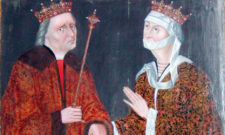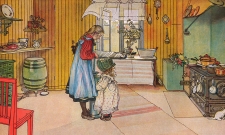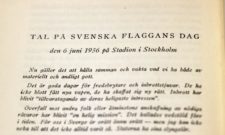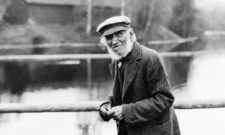Shop our historical maps
Culture
Only Sweden Swedish Christmases have
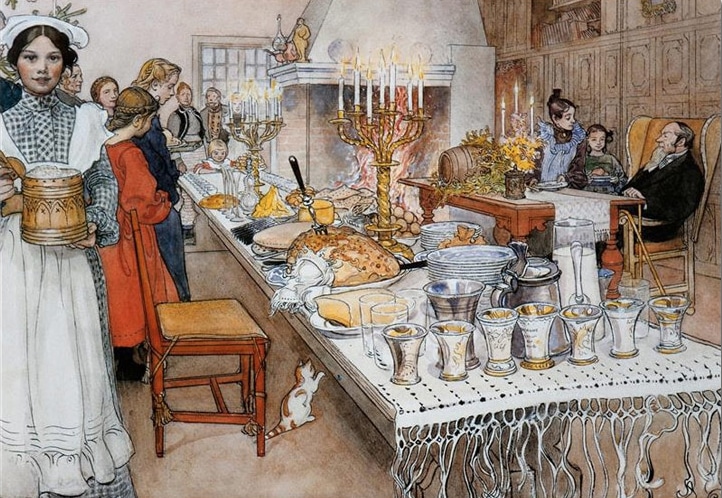
Dec
Christmas is a highlight of the year for many, but for many others it's also a stressful time, perhaps even difficult. Food needs to be cooked, the house needs to be cleaned, Christmas presents need to be bought, and then you have to outlive your family too. So why do we celebrate Christmas?
First of all, Merry Christmas from Allmogens to all of you! So, why celebrate Christmas? Why did previous generations make this effort in the dead of winter to celebrate Christmas?
The folklorist and philologist Hilding Celander writes on the first page of his book Nordic Christmas that "this whole festive season of home, childhood joy, generosity and abundance of light seems doubly dear and indispensable to us northerners against the backdrop of the long autumn darkness. How much grayer and colder our life would be up here in the hyperborean winter darkness without this blazing hearth of heat!"

Sure there are those that diminishes our Christmas traditions, and those who believe that the Urdu language is just barbarism, but we are all the more likely to find our traditions valuable and a source of joy. This applies both to the ancient traditions of the ancient Christmas celebrated here in the Nordic countries before Christmas festivities were dressed in Christian garb, the younger elements that came with Christianity, and all the more modern Christmas traditions brought from abroad.
"The motley variety of customs and beliefs which in olden times filled the peasant's Christmas and gave it a richness of content which we children of late times can scarcely comprehend, probably more than one is astonished at the mixture of Christianity and paganism which appears everywhere."
Nils Gabriel Djurklous
The quoted words are Nils Gabriel Djurklous from the book "Customs and life of the Unnarsboar" from the year 1874.
Why was Christmas celebrated in the Nordic countries?
Today, the most common reason we celebrate Christmas is to commemorate the birth of Jesus. But Christmas has always been much more than that. Now I'm not going to tell you what Christmas is, because today it has different meanings for everyone. But I can share with you Hilding Celander's understanding of what Christmas been, which is probably also in line with how the Nordic peoples have seen Christmas for a very long time.
"While our other Nordic annual celebrations have been closely linked to nature's life, to its awakening or to the climaxes of its power development (such as the spring festival, the midsummer festival and the harvest festival) and is almost entirely marked by it, Christmas is instead a culture-firm.
It comes at a time of year when man up here in the North is at his most abandoned by all the life-giving and gentle forces of nature, and seems mercilessly at the mercy of winter darkness and winter cold.
But at that moment, it is as if the Nordic has gathered all his assets with a huge effort. All that the past year's labours and nature's gifts have accomplished in common, he lays out in the light of the Christmas bonfire, and so renews his alliance with all life-promoting and nourishing powers, in defiance and defence against all debilitating and life-destroying, which threatens in the darkness and cold outside the farm's knots.
It is the celebration and triumph of human cultivation. And therefore it also reflects Nordic culture in its different aspects and in its different phases of development more richly than all the other popular annual celebrations put together - At the same time, Christmas has been and still is a home and family party more than any other. It forges closer ties between the members of the small circle who together fight life's battles, sharing its good and bad fortunes. It is a celebration not only to annual, for annual growth and salvage, but also to Fridar, for the preservation of the state of peace which unites kinsmen.
In the old days it also renewed for a few days the unbreakable ties that united the living of the family with its deceased dead, the kinsmen who had been raised, as Snorre calls it. - And finally, the old Christmas, as the great focal point of that year, has also turned its eyes forward. It has been sought to reveal, by omens and deceptions, what lay hidden behind the veil of the future, and to secure - as far as it was in human power - the destinies of that future, with the help of religion and magic." (Hilding Celander, Nordic Christmas, 1928)
In today's Swedish Christmas celebrations there is content from all times, or as Hilding Celander put it in 1928: "Thus in Christmas the threads run together from the most diverse directions"
Some of these countless threads originated in other countries. The threads of Christianity have run through the Swedish cultural fabric for a thousand years. The threads of ancient paganism that can still be found in the tapestry today stretch back even further in time. The Christmas tree, which originated in Germany, was woven in during the 19th century, and Donald Duck is a relatively new thread.
The path from Viking winter solstice celebrations to Christmas Eve was one of change in society, with monks and traders bringing influences from outside. Sweden's Midwinter Blossom was woven in with international traditions such as the sun cult in the Roman Empire, the birth of Jesus in Israel and the popular mystery games in Germany.
But in the end, all these threads that make up the Christmas fabric have been woven by the several million dead people who lived in Sweden before us, our ancestors. As Vilhelm Moberg wrote in his text Swedish aspiration In 1941, while the Second World War was raging on the continent, "What Sweden is today, it has been made by dead and living Swedes, and no one else."
In this tapestry you can find threads woven by Goths, Swedes, Virginians, Smålanders, Scanians, Hallanians, Norwegians, but also Swedes, Sami, Jews, and other peoples who have lived and live in the Nordic countries. The Swedish tapestry is part of a larger Nordic tapestry, which in turn is linked to the European tapestry of Christmas traditions.
It's only natural that new threads are woven in by new generations, whether they have roots in the North or roots stretching to distant lands. That will never change.
I don't think many people are seriously worried that someone will take away their Christmas tree, Donald Duck or their rice à la Malta, as the secondary school teacher implied in Aftonbladet. On the other hand, it is understandable that people feel irritated when someone tries to diminish and unravel the cultural fabric woven by their parents, grandparents and ancestors by pointing to and pulling at individual threads in the enormous fabric that originated in other countries.
It is even more irritating when the Swedish state, as it has done for centuries and still does today, takes the right to centrally plan the weaving of our culture. The state has hijacked culture, because they want to hold the threads themselves. Moreover, if they find any old threads they do not like, they simply tear up the fabric and sew in new threads to reflect their contemporary world view and values, befitting any totalitarian state power.
Now I'm not going to (in this article at least) go into more detail about how the state has tried to beat the Sami culture out of the Sami, the river valley from the river valleys, or pagan customs and regional culture from the Swedish commonwealth, so I can leave this by saying that the only people who have the right to weave threads into this fabric are the people who live in Sweden. The state has nothing to do with culture.
In the same way that Hilding Celander concludes his book Nordic Christmas I conclude this Christmas greeting with a text by Nils Gabriel Djurklous from his book Customs and life of the Unnarsboar (1874).
"Alongside a thread of the whitest and sharpest Christian colour, another of the darkest paganism continues in the same border, and so it goes on throughout. Light and darkness do not pass into each other by the same mediating shadows as in our day; they break against each other with sharp edges, and produce the most marvellous mixture of colours, without therefore disturbing the harmony of the whole.
We look at it with wonder, and can hardly conceive the possibility of such a combination of devotional songs and prayers with stormy and wild games, of serious Christianity according to the opinion of the time and the grossest superstition, but nevertheless we cannot deny that the whole picture, fantastic as it is, possesses an indescribable something which powerfully appeals to us.
And whence is this, if not because the same Swedish spirit which animates our minds, manifests itself here also, though more shrouded in darkness and bound up in ancient mystical notions, the origin of which we can only guess at the present stage of research, but the true meaning of which the future will one day fully ascertain.
May we therefore with all diligence, and while there is yet time, seek to bring together these scattered remnants of ancient faith and practice, but beware the temptation to measure them by the yardstick of the present. For as surely as we ourselves once hope for the gentle judgment of posterity, we must be cautious in judging past times. In many respects, they have more right to demand leniency from us than we have from our descendants."
Nils Gabriel Djurklous, Customs and life of the Unnarsboar (1874)
With that said, Merry Christmas!
Subscribe to YouTube:
If you appreciate Allmogens independent work to portray our fine Swedish history and Nordic culture, you are welcome to buy something nice in the shop or support us with a voluntary donation. Thank you in advance!
Support Allmogens via Swish: 123 258 97 29
Support Allmogens by becoming a member
Support Allmogens in your will
